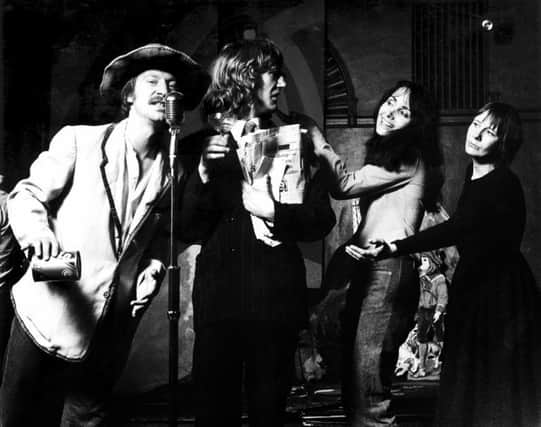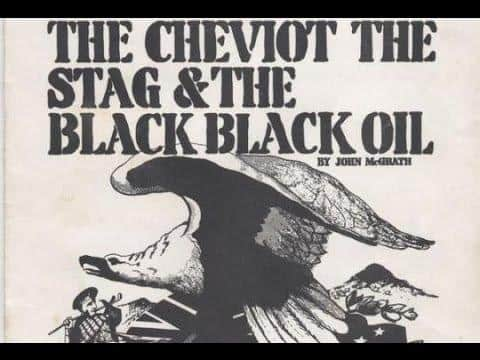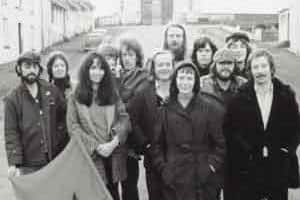The Cheviot – a play for both past and present


It is difficult to think of any other piece of Scottish theatre which has created such a lasting presence. Certainly, there has been nothing written and performed about the Highlands and Islands which came close to it in terms of resonance and impact. Integral to these claims is that it emerged from a group of exceptional talents.
The visionary who brought it together was John McGrath, a gentle, charismatic man who had an established reputation as a film and television director and writer before he formed the 7:84 Theatre Company, first in England and then in Scotland, as a vehicle for agitprop, political theatre. John was married to the actress Elizabeth Maclennan whose family’s origins were in Rogart. His interest in the Clearances and associated cruelties was formed through that connection.
Advertisement
Advertisement
All this started to come together in 1972. John saw The Great Northern Welly Boot Show on the Edinburgh Festival Fringe; a satire on the Upper Clyde work-in co-written by and featuring Billy Connolly. It was the hit of the Fringe and, as Bill Paterson, who was in it, recalled: “It wasn’t great theatre but it kick-started things”.


Bill, Alex Norton and John Bett, who had been friends at the Glasgow Citizens Youth Theatre, were recruited by John McGrath to become the three multi-role pillars of The Cheviot. He also wanted Gaelic content and asked friends in Edinburgh who he should contact for advice.
This led him and Liz to the door of Dolina Maclennan. She recalls: “It was ages afterwards he told me he did a double-take. The only Gaelic speakers he knew in Sutherland were in their 80s and 90s and that’s what he had expected”. Instead, they were confronted with a vibrant personality who had just been touring with Scottish Ballet, singing in a production called An Clò Mor.
“They came in for a cup of tea and by the time they left, John had asked if I would join the company. I had two young daughters but they offered to pay for someone to come and look after the children while we were on tour. That is how it all began. I didn’t know the others until we met in a disco above the Lyceum for rehearsals”.
Advertisement
Advertisement
All of the performers were not just actors but highly creative contributors to the evolving script. The artist John Byrne, whose fame lay ahead, created a fabulous pop-up set which could be transported easily from one venue to the next. Alan Ross was a quality fiddle player who became the mainstay for the post-show dances. Amazingly, it all came together in the space of a few months.


I was fortunate to be in the right place at the right time, and lifelong friendships were forged. The West Highland Free Press had been launched a year earlier and was dealing in stories which fitted closely into the narrative of The Cheviot – the continuing exploitation of the region’s resources; the senseless erosion of a priceless culture; the power and excesses of landlordism.
All this topicality was assimilated into The Cheviot script against the backdrop of history. At that time, construction companies were scouting the west coast for locations in which to build concrete oil platforms. In Harris, there was the celebrated tale of Sir Hereward Wake and his plans for an Amhuinnsuidhe by-pass. Such stories were gold-dust in the hands of these maestros of parody and humour.
The great thing about the Cheviot was that it never descended into a finger-wagging lecture about the injustices of history, as it might well have done in less talented hands. Drama, humour, pathos, music created a theatrical experience from which every audience member was left to draw his or her own conclusions.
Advertisement
Advertisement
There were lots of great character parts in The Cheviot and my own abiding favourite was Andy McChuckemup, the Glasgow spiv, determined to exercise his entrepreneurial talents in the Highlands, where previously there was “hee-haw but scenery”. There have been so many stories in the intervening half century which match the McChuckemup profile that he has remained a permanent presence.
Much of the Cheviot’s impact lay in the fact that so much of Highland history had been suppressed for so long. It was still there in the consciousness of the people but it certainly was not taught or, to any great extent, discussed. When presented in this unexpected theatrical form, the impacts were electrifying.
In one scene, the call from the Duke of Sutherland for volunteers to fight in the Crimean War was met by a stinging riposte from Alex Norton, who had moved into the audience, followed by sheep-like baa-ing by the entire cast. Dolina recalls the effect as “spine-chilling” and the “sense of shock” on the audience’s faces as the history was related in cold fact. They had, quite literally, heard nothing like this before.
In Tarbert, when John Bett was playing the part of Patrick Sellar, a woman in the audience was moved to stand and invoke curses upon him. Dolina was intrigued by that reaction, did her research and found that a son of Sellar had been the factor in Harris “and I don’t think he was much better”.
Advertisement
Advertisement
On the first tour, the Caberfeidh Hotel was the Stornoway venue and I have my own abiding memory of Murdo Macfarlane, the Melbost Bard, clutching John McGrath by the hand and telling him: “If I die tomorrow, I will die a happier man for having seen the history of my own people told in this way”.
Dolina remembers when The Cheviot reached Castlebay, Father Angus Macqueen positioned himself at the ferry, handing out 7:84 badges and shouting at people to head straight for the hall to see this play because of the story it told and the truths it would reveal.
Such anecdotes give some sense of just how powerful the play and performances were. There was no social media in these days and it was word of mouth which went ahead of the company and ensured that everywhere 7:84 went, they played to a packed house.
There was one exception to that rule. Arriving in Ness “in a howling gale”, Bill Paterson recalls there was a clash with prayer meetings (he thinks) and the only people who turned up were a minbus of school pupils from the Nicolson. It was agreed the best course of action was to cancel the performance and provide them with tickets for the following night in Stornoway. The cast was then spirited off to a bothan where “we performed half the show”.
Advertisement
Advertisement
Bill has another recollection of playing in Broadford Hall in Skye when the island’s landed gentry had apparently made a collective decision to turn out in force, in a display of stiff upper lip. “Johnny Bett used to stand at the exit to pick up the audience comments and he heard one of them declare very loudly: ‘It’s such fun to be able to laugh at oneself’.”
As far as touring the Highlands and Islands was concerned, 1973 was “the year of the Cheviot”. However, its shelf life was extended and the audience vastly increased by the fact that BBC TV made it into a production for its “Play for Today” series which, in these days, attracted vast audiences.
Bill recalls how that came about. The original BBC plan had been to film Just Another Saturday by Peter Macdougall about sectarian tensions in the west of Scotland. However, their recce coincided with some actual sectarian tensions arising out of a football match and it was decided to put that project on hold. The director, John Mackenzie, said: “We’ve got the budget”, so they set about making The Cheviot instead. It was filmed in Dornie Hall and transmitted UK-wide to great acclaim.
At its heart, The Cheviot was about the land question and the power of those who had acquired it by whatever means. While 7:84 referred to the maldistribution of wealth in the UK, a statistic John McGrath had picked up from The Economist, that gap in numbers would have seemed positively democratic compared to the structure of land ownership in the Highlands and Islands.
Advertisement
Advertisement
In the 1970s, the land issue had a relatively high profile in Scotland which The Cheviot both reflected and contributed to. The West Highland Free Press played its part. A few years later, James Hunter’s seminal book, The Making of the Crofting Community, provided a devasting riposte to historical revisionism. In Perthshire, a nonagenarian, John McEwen, laboured tirelessly to compile the first “Who Owns Scotland?”. But then, not a lot happened.
Much later, though almost exclusively in relation to crofting land in the Western Isles, it was possible to make some progress on community land ownership but that has largely ground to a halt over the past decade. In Scotland as a whole, no progress at all has been made, or even attempted, in breaking the stranglehold of the great estates; quite the reverse. As in many other respects, there is as much need today as there was 50 years ago for the kind of messages The Cheviot conveyed so successfully.
So why has nothing like it been attempted since? “They’re all frightened”, says Dolina Maclennan, and she is probably right. There would be little prospect today of public funding to support a production as subversive as The Cheviot. So play it safe, keep in Creative Scotland’s good books and don’t rock the boat. Or maybe the same levels of talent and commitment just don’t exist?
Certainly there is no shortage of current material. Hedge funds and sundry speculators buying up huge tracts of the Highlands to fill their boots from “re-wilding” while de-peopling continues … flogging off the seabed to multinational companies at knockdown prices for offshore windfarms … HPMAs, need I say more? … and I’m sure McChuckemup Marine Solutions, masters of the dodgy contract, would have taken an interest in the ferries market. All good themes waiting for satirists who can link past with present.
Advertisement
Advertisement
It’s Scotland’s loss that they don’t exist and that The Cheviot, the Stag and the Black, Black Oil will remain what it has been for the past 50 years – a one-off of blessed memory, with powerful messages that cried out for responses. And still do.